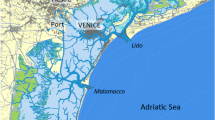Abstract
Three years of mobile barrier operations have been simulated with a hydrodynamic model to check the efficiency of the barriers in defending the city of Venice from flooding. The simulations have been carried out in the actual situation and with a sea-level rise of 30 and 50 cm. Moreover, the interference of the barrier operations with the ship traffic has been studied. It is found that without a security increment for the forecasted water levels, the mobile barriers cannot defend completely Venice from flooding due to the uncertainty in the forecast. With a security increment of 10 cm, the barriers work well in actual conditions but still cannot avoid flooding with a global sea-level rise. The interference with the ship traffic is acceptable under actual conditions but becomes prohibitive with a sea-level rise of 50 cm, when nearly two-thirds of the ship passages are blocked or delayed.









Similar content being viewed by others
References
Bras RL, Harleman DRF, Rinaldo A, Rizzoli P (2002) Obsolete? No. Necessary? Yes. The gates will save Venice. Eos 83(20):217–224
Bonato N, Ferla M, Umgiesser G, Zen G (2002) Eventi di acqua alta in Laguna di Venezia. Approfondimenti e confronti sugli effetti di circolazione indotti dal vento. In: Il dissesto idrogeologico: inventario e prospettive. Atti dei convegni lincei 181, Accademia Nazionale dei Lincei, Roma, pp 307–319
Canestrelli P (1999) Il sistema statistico del Comune di Venezia per la previsione del livello della marea in città. Risultati teorici e in fase operativa. Venezia, Centro Previsioni e Segnalazioni maree, pp 17, 10 fig
Collegio Di Esperti Di Livello Internazionale (1998) Report on the mobile gates project for the tidal flow regulation at the Venice lagoon inlets. June, pp 48
Dazzi R, Rossi G, Rusconi A, Tomasin A (1984) Meteorologia e laguna: l’ammonimento delle più recenti bufere per l’efficacia degli interventi di difesa. Istituto Veneto di Scienze, Lettere ed Arti, Rapporti e Studi, vol. X, pp 103–127
IPCC (1990) Climate change: the IPCC Scientific Assessment. Cambridge University Press, Cambridge, pp 365
IPCC (1995) Climate change 1995–the science of climate change. Cambridge University Press, Cambridge, pp 572
IPCC (2001) Climate change 2001–the scientific basis. Cambridge University Press, Cambridge, pp 881
Magistrato Alle Acque (1997) Interventi alle bocche lagunari per la regolazione dei flussi di marea–Studio di impatto ambientale del progetto di massima, Allegato 6, Tema 5, pp 163
Pirazzoli PA (2002a) Did the Italian government approve an obsolete project to save Venice? Eos 83(20):217–223
Pirazzoli PA (2002b) Water level at Punta Salute. Eos 83(20):217–223
Pirazzoli PA, Umgiesser G (2003) E se il progetto “MOSE” fosse già obsoleto? Technical Report ISDGM-CNR 256, pp 21
Umgiesser G (1997) Modelling the Venice Lagoon. International Journal of Salt Lake Research 6: Kluwer, The Netherlands, pp 175–199
Umgiesser G (1999) Valutazione degli effetti degli interventi morbidi e diffusi sulla riduzione delle punte di marea a Venezia, Chioggia e Burano. Atti Istituto Veneto di Scienze, Lettere ed Arti, 157, pp 231286
Umgiesser G (2000) Modeling residual currents in the Venice Lagoon, in interactions between estuaries, coastal seas and shelf seas, Ed. T. Yanagi, pp 107–124
Umgiesser G, Bergamasco A (1993) A staggered grid finite element model of the Venice Lagoon. In: Morgan K, Ofiate E, Periaux J, Zienkiewicz OC (eds) Finite elements in fluids. Pineridge, Barcelona
Umgiesser G, Bergamasco A (1995) Outline of a primitive equation finite element model. Rapporto e Studi, XII, Istituto Veneto S.L.A., Venezia, pp 291–320
Umgiesser G, Matticchio B (2003) Simulazione delle chiusure delle barriere mobili per gli anni 2000 e 2001 con un innalzamento del livello marino. Rapporto per il Comune di Venezia, pp 29
Umgiesser G, Melaku Canu D, Cucco A, Solidoro C (2004) A finite element model for the Venice Lagoon. Development, set up, calibration and validation. J Mar Syst 51:123–145
Zecchetto S, Umgiesser G, Brocchini M (1997) Hindcast of a storm surge induced by local real wind fields in the Venice lagoon. Cont Shelf Res 17(12):1513–1538
Acknowledgements
The authors want to thank the Venice Municipality for their support as well as Afro Massaro, Alberto Tomasin, and Paolo Pirazzoli for the useful discussions during the preparation of the manuscript. Moreover, they want to thank Paolo Canestrelli and his collaborators for the data used in this study.
Author information
Authors and Affiliations
Corresponding author
Additional information
Responsible Editor: Paulo Salles
Rights and permissions
About this article
Cite this article
Umgiesser, G., Matticchio, B. Simulating the mobile barrier (MOSE) operation in the Venice Lagoon, Italy: global sea level rise and its implication for navigation. Ocean Dynamics 56, 320–332 (2006). https://doi.org/10.1007/s10236-006-0071-4
Received:
Accepted:
Published:
Issue Date:
DOI: https://doi.org/10.1007/s10236-006-0071-4




